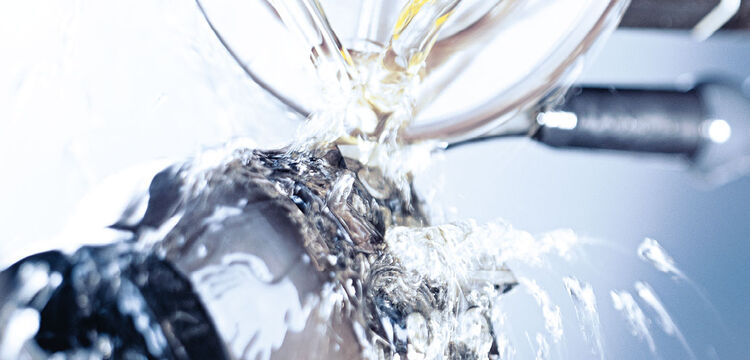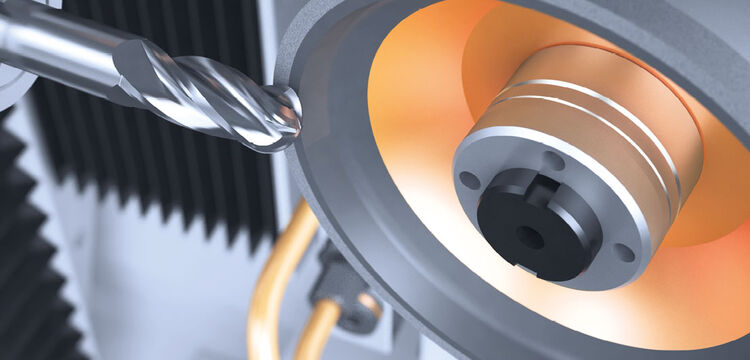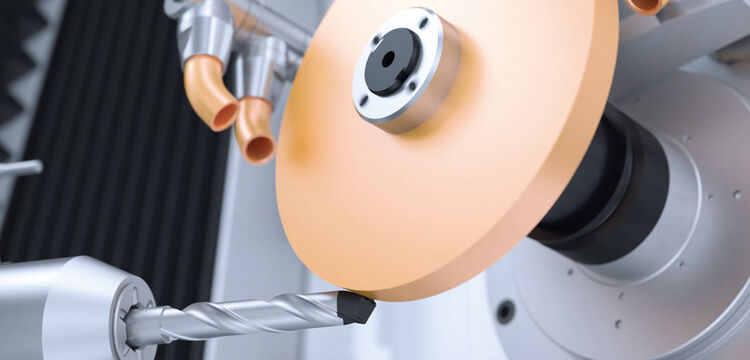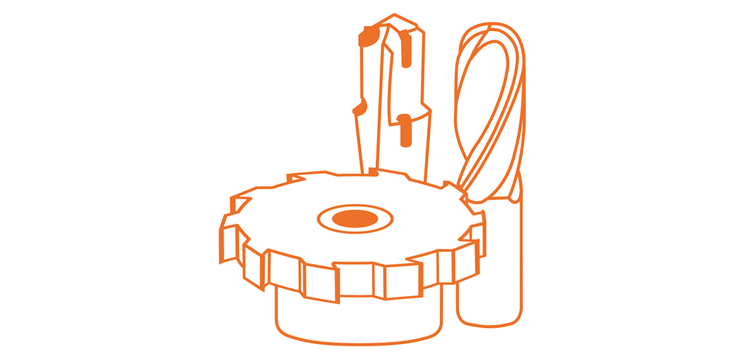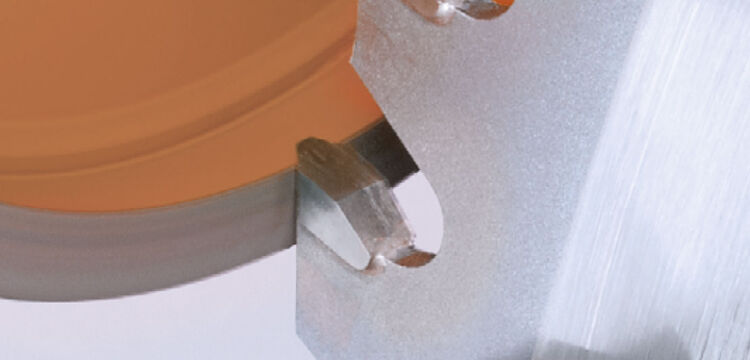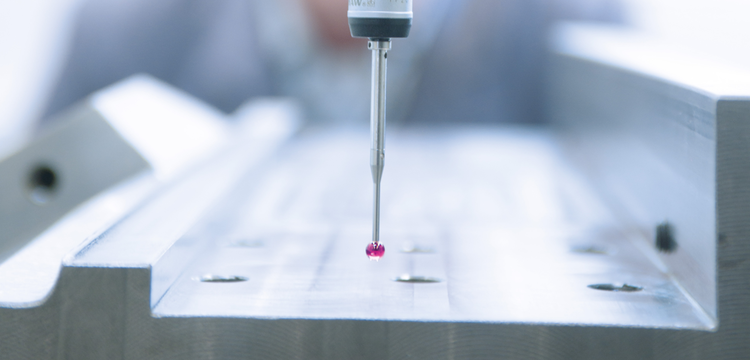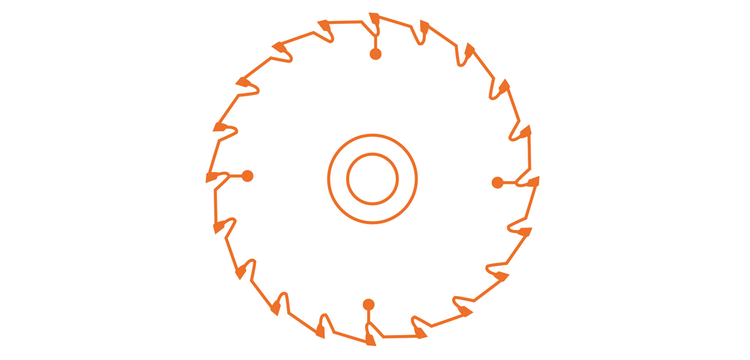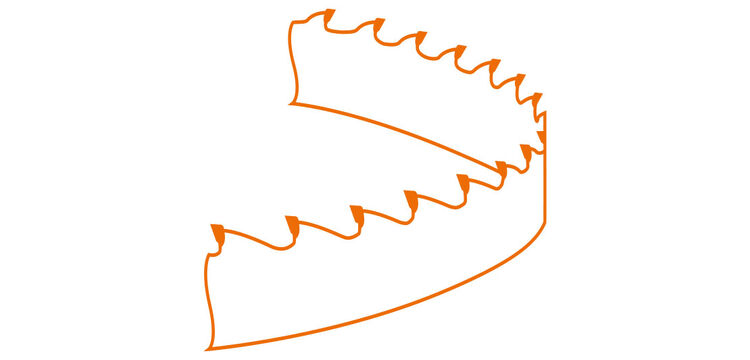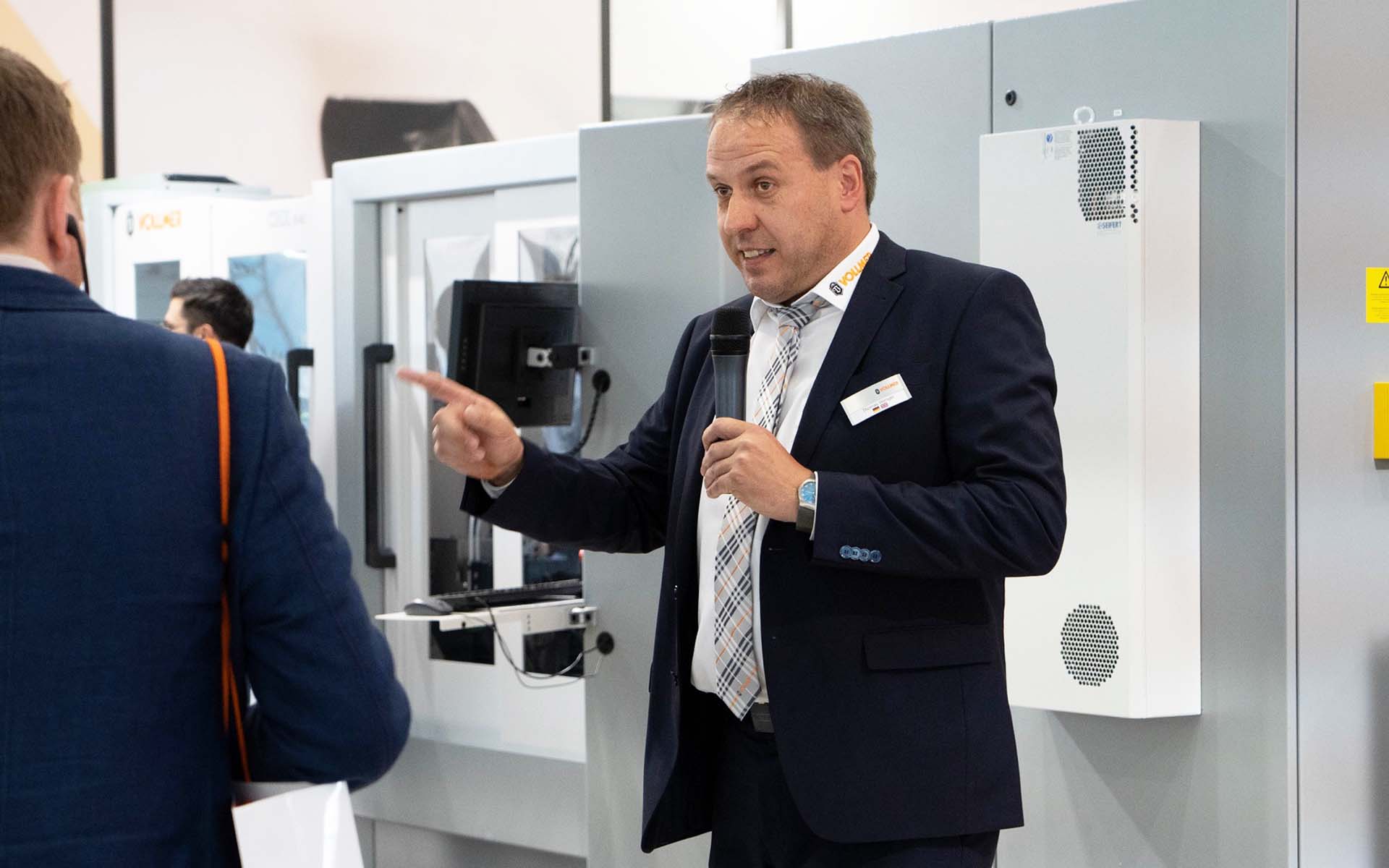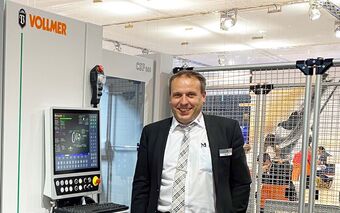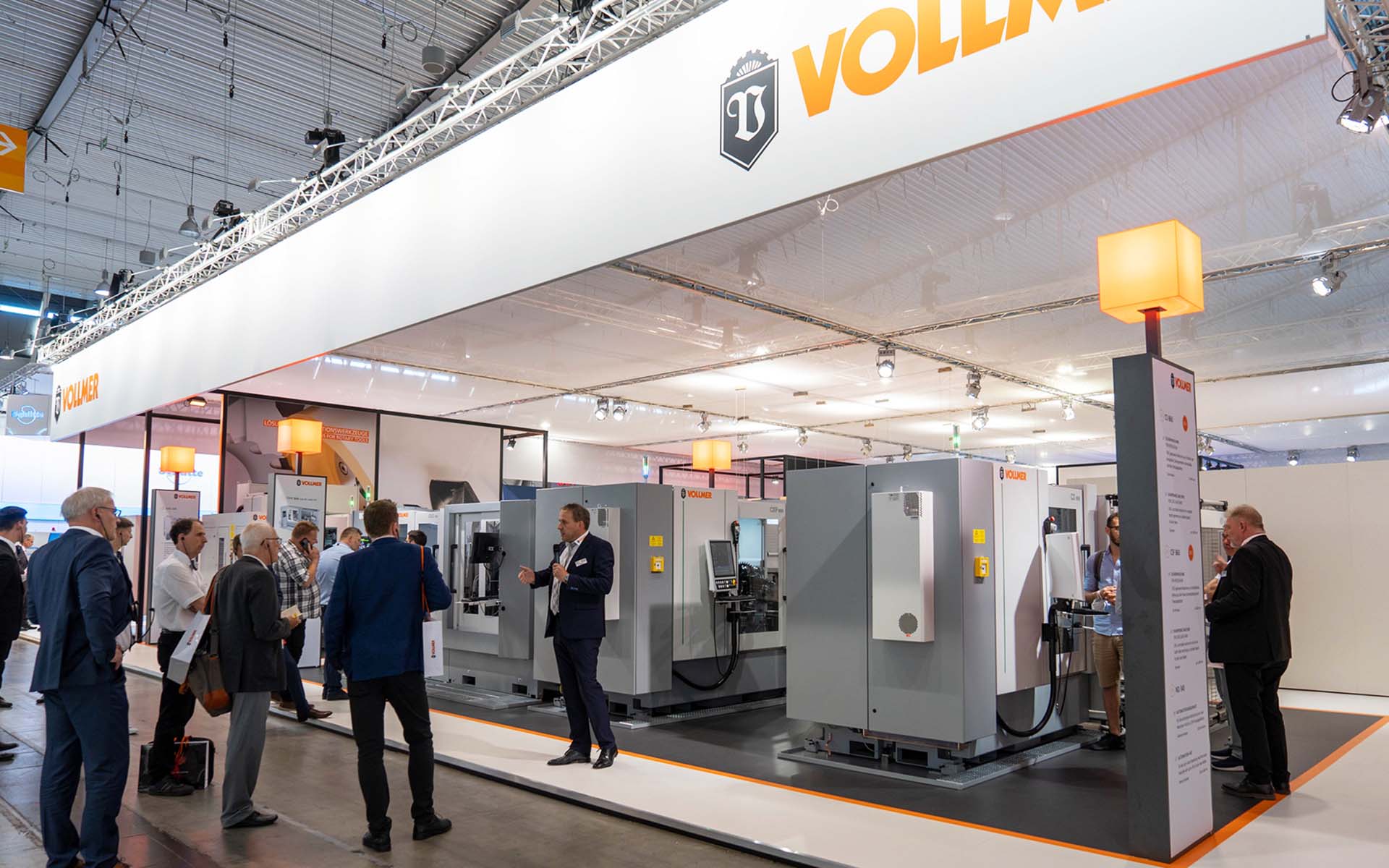We detected, that your browser supports another language than the called one. This page is also available in your language! Would you switch to this page in your language?
VOLLMER Has a New ‘Side’ To Its Saw Sharpening Range 2022-08-01
to overviewParadigm shifts in technology are something that VOLLMER has been abreast of since the company’s inception in 1909. With saw blade production and servicing instilled in the very DNA of VOLLMER, the Biberach manufacturer has been the industry benchmark for generations. To retain its industry-leading position, VOLLMER has now introduced its next generation of saw blade sharpening and servicing machines, the CS860 and CSF860. To celebrate the launch of the latest generation machines, VOLLMER’s Thomas Wenger discusses the new CSF860 technology for side grinding saw blades in more detail.
With two new machines arriving for saw blade manufacturers; Thomas, the Product Manager for Carbide Saws and a seasoned expert with 24 years of service at VOLLMER discusses the concept behind the two new machines that will supersede the CHD270 and CHF270 saw blade processing machines. Thomas says: “The CHD and CHF machines were based on a completely different construction to our new technology. The CHF side grinding machine was designed in 2000 and we evolved this machine until we reached the limit of what could be achieved with the existing construction. Now, with a new foundation, new drives and software technology – we can add new benefits for our customers.”
Rather than strive to squeeze further benefits from an ageing platform, VOLLMER applied its expertise and started over. Alluding to this, Thomas says: “We identified our development goals and we started to design the CS and CSF machines. The base, the housing and everything else is now completely different to before. We have designed both new machines with the same kinematics, housing, structure and polymer concrete base, so we can have a modular foundation. This makes it easier for us to internally streamline production and reduce lead times. It also makes the machine easier for the operator to handle as there is greater synergy between the CS and CSF machines. This creates uniformity with regard to loading, setting-up, the view and ergonomics and also the programming. This uniformity of technology was our target, adopting the same CNC, operating philosophy and also the latest drive technology.”
With a new foundation, construction, frame, software and hardware – the new CSF860 is an entirely different machine from its predecessor, the CHF270. As with all machines in the VOLLMER portfolio, the foundation blocks of ‘ALL’ product development are flexibility, productivity, reliability and quality.
The key benefits
For any manufacturer comparing the machine to its predecessor, the direct comparisons will no doubt be impressive in terms of the increased capacity, flexibility and potential of the CSF860 – all in the same footprint. But, the key concerns for manufacturers at present are energy costs, productivity rates and automation, and the diminishing skill base in the employment market.
So, as a baseline statistic, the CSF860 is 2 to 4% more productive than the previous CHF270 – a result of the machine kinematics and design, but that is just a base figure. Now, you can add up to 20% cycle time saving derived from ingenious software updates that precisely calculate the grinding area and eliminate ‘air cutting.’ There is a new saw carrier and R2 axis for flange management system that eliminates 10 to 15 minute changeover times between different blade types. The manual measuring of 2 to 3 minutes per saw blade can be eliminated with the new measurement and calibration system – a system that also eradicates the 25+ seconds of non-productive grinding wheel calibrating and checking.
Whilst these statistics typify just a few of the cycle time and automation benefits, energy consumption has been reduced by more than 10%. On top of this, there are ingenious software updates and the integration to the IoT gateway – the result is a cascading flow of benefits that will delight any customer buying the new CSF860. With flexibility and productivity mentioned above, the foundation pillar of reliability has been infused throughout the new CSF860 with the introduction of new technologies.
The build quality of the VOLLMER CSF860 is assured. The new construction introduces ergonomic features for the operator, such as a ‘deep cut’ door that opens further than before. This gives the operator greater access to the work envelope, and for heavy blades that may need lifting via an overhead gantry, the new door design also opens at the top for overhead access. A new maintenance door has also been introduced for quick access to critical components and the control cabinet has also been moved to a more ergonomic position – all of these instantly recognisable differences are the result of customer feedback that could only be actioned by completely starting from the ground up with a new machine concept.
Within this new concept, VOLLMER has upgraded all motors to servo motors for improved reliability, speed and efficiency. As Thomas adds: “Uniformity of technology was our target in developing the new machines, adopting the same CNC, operating philosophy and also the latest drive technology. In the past, we used some servo motors with standard Asynchronous motors. Now, all motors, grinding spindles and axes are servo driven. We have seven motors on the CSF860 side grinder with an optional 8th-axis R2 saw carrier cross-axis. The axes also include linear CNC axes and two CNC grinding spindles. As well as being more reliable and stable, the servo-driven grinding spindles provide a higher quality saw blade, and we can now conduct different in-feed and cutting speed rates on each tooth. This improves the surface quality of the cutting edge and brings more flexibility to the grinding process. Customers can now do whatever they wish.”
Expanding on the servo motors, Thomas says: “Previously, standard motors had power and encoder cables, by evolving to servo OCT (One Cable Technology) technology there is just one cable. This means there are fewer cables and switches, reduced power consumption and it is easier to change a single cable – something that reduces the future service costs for the customer.”
Expanding upon the reliability aspect of the new machines, Thomas says: “No new VOLLMER machines use hydraulic systems - it is all pneumatic. This eliminates hydraulic oil, the potential for spillage or contamination of the coolant and the wider workshop. This also removes the need for filter changes.”
Whilst machine reliability and performance are essential for any machine tool builder, service and support are critical facets in creating customer confidence. Here, VOLLMER has its impressive IoT Gateway, as Thomas says: “With Industry 4.0, we can undertake service from anywhere. We can update the machine components and software remotely. Our remote system can also email the customer when a batch of saws is complete, or if there is a disruption during a production cycle - emailing the customer their complete machine status. The active dashboard can be accessed via a mobile phone or tablet to provide a complete up-to-date status report.” The machine is based on a win10 IoT operating system. The integrated IOT gateway, which is responsible for data communication with the outside world, works with a hardened Linux system, thus guaranteeing network security.
Quality, Speed and Set-ups
From a quality perspective, VOLLMER has really taken the new CSF860 side grinder to a new stratosphere, and with the integration of IoT and software advances, the customer will instantly enjoy huge gains when compared to its CHF270 predecessor.
Acknowledging the ingenuity of the new measuring technology, Thomas says: “Our stable production processes are derived from three measuring devices. First, we have the latest measurement innovation from a world leader in precision measurement technology that is repeatable to 1μm. It has a high-end 3D spherical system that provides remarkable accuracy.”
“The second system is a new measuring cube for the grinding wheels. It has an absolute fixed point and it gives knowledge of the grinding wheel position. If there is a temperature fluctuation in the machine or spindle, this fixed point will compensate for all other parameters. We can measure the grinding wheels whilst the machine changes the saw blades. In the past, it was necessary to compensate the grinding wheel by measuring the tooth - this was unproductive time. Integrating this process increases grinding stability whilst reducing unproductive time.”
“This grinding wheel measurement is pre-programmable. The manufacturer generally knows they need to recalibrate the wheel every 5 or 10 saw blades. The customer can define the measuring point, whether it be by the number of teeth or saw blades processed. Furthermore, the customer is not losing production time. As an example, the 20 to 25 seconds wheel measuring process can be undertaken simultaneously with the saw blade changeover which also takes 25 to 30 seconds. This effectively enables every saw blade to be measured to a precision level of roughly 2μm to guarantee process stability without losing production time.”
“We have now added our third measurement device to the new CSF860 side grinder - our acoustic sensor that was previously on the CHD machine. This promotes very fast setups by combining technologies. With the probe, the measuring cube and with the acoustic sensor, we are bringing everything together by checking the tooth with the grinding wheel. The wheel senses the tooth and the acoustic sensor knows if we have the right in-feed – making all three measuring devices work together. Combining this closed-loop system with our polymer concrete foundation puts our quality and precision on a completely different level to all other machine builders.”
Integrating this measuring technology with the IoT gateway to complete the quality control process, Thomas says: “Now, if an end-user has quality concerns with their saws, our customer can undertake a final inspection before dispatch. When a saw is complete, a measuring sequence can be applied to one tooth or all teeth on the blade. Our customer can select their measurement parameters. This process creates an XML file for quality and traceability to ensure each saw is 100% correct. Previously, saw manufacturers and service shops used manual measuring equipment and inspected every fifth or tenth saw blade for conformity - and then recorded the data. Now, a fully automated sequence can be integrated to save considerable time.”
Looking to the future
Discussing the bold move to phase out the CHD and CHF machines, Thomas concludes: “Product development teams meet weekly with worldwide sales colleagues and collect all the sales engineers and customer requests - the list is huge. The base point for our development is the well-built technology from before. We analyse the technology and how we can improve the machines, but on the other side, there is a huge list of customer requests or needs. So, we have to understand the customer requests and integrate them with product development.”
“For example, we had the electrical cabinet at the back of the machine - but if you have three machines alongside each other, there is only 900mm of space between the machines. The customers have fed this response back to us and on the new machines, we have moved the electrical cabinet to a side where customers would have the gangway. This can also be seen in the new frame and door design where we have improved access to the machine.”
With regard to the changing requirements of the market, Thomas says: “Automation is the biggest factor. Machines need to make more and more by themselves. Our Industry 4.0 technology has provided comprehensive remote support during Covid and our energy efficiency and productivity enhancements are reducing the cost per square metre of production for our customers – we will always drive this forward.”
Your Contact
VOLLMER UK LTD.Town Street, Sandiacre
Nottingham NG10 5BP
